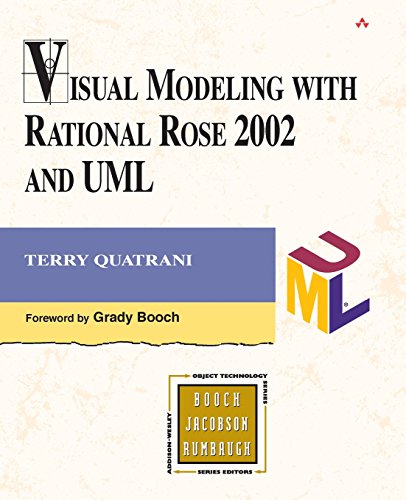

Most ebook files are in PDF format, so you can easily read them using various software such as Foxit Reader or directly on the Google Chrome browser.
Some ebook files are released by publishers in other formats such as .awz, .mobi, .epub, .fb2, etc. You may need to install specific software to read these formats on mobile/PC, such as Calibre.
Please read the tutorial at this link. https://ebooknice.com/page/post?id=faq
We offer FREE conversion to the popular formats you request; however, this may take some time. Therefore, right after payment, please email us, and we will try to provide the service as quickly as possible.
For some exceptional file formats or broken links (if any), please refrain from opening any disputes. Instead, email us first, and we will try to assist within a maximum of 6 hours.
EbookNice Team

Status:
Available4.7
17 reviews(Ebook) Visual Modeling with Rational Rose 2002 and UML 1st Edition by Terry Quatrani, Grady Booch - Ebook PDF Instant Download/Delivery: 9780201729320 ,0201729326
Full download (Ebook) Visual Modeling with Rational Rose 2002 and UML 1st Edition after payment

Product details:
ISBN 10: 0201729326
ISBN 13: 9780201729320
Author: Terry Quatrani, Grady Booch
Within the space of just a few years, the Unified Modeling Language (UML) has emerged as the design medium of choice for developing large-scale distributed object applications. The UML's standard semantics and notation for describing object structure and behavior make it particularly well suited to this function. Augmented by the Rational Unified Process, an extensive set of software development guidelines, and the Rational Rose visual modeling tool, the UML greatly facilitates the process of developing quality object-oriented applications that meet both deadlines and requirements.
Fully updated and revised, Visual Modeling with Rational Rose 2002 and UML is a comprehensive introduction and tutorial that shows how to use a tool (Rational Rose 2002), a process (the Rational Unified Process), and a language (the UML) to successfully visualize, specify, document, and construct a software system. This timely new edition, written by the UML Evangelist at Rational Software Corporation, breaks the technology down to its essentials and provides clear explanations of each element. The book follows a simplified version of the Rational Unified Process from project inception through system analysis and design. The popular sample case study from the previous editions (a registration system for a fictional university) has been retained and updated, now better illustrating the iterative development process in practice, the UML in action, and the proper application of Rational Rose 2002. Newly updated appendixes demonstrate code generation and reverse engineering using Rational Rose 2002 with the C++, Visual C++, and Visual Basic programming languages. In addition, a handy glossary defines keyobject technology and software modeling terms.
Topics covered include:
Creating use cases Finding objects and classes UML stereotypes and packages Scenarios, sequence diagrams, and collaboration diagrams Discovering object interaction Specifying relationships, association, and aggregation Adding behavior and structure Superclass/subclass relationships and inheritance Object behavior and Harel state transition diagrams Checking for model consistency Specifying, visualizing, and documenting system architecture The iteration planning process
(Ebook) Visual Modeling with Rational Rose 2002 and UML 1st Edition Table of contents:
Introduction
What Is Visual Modeling?
The Triangle for Success
The Role of Notation
History of the UML
The Role of Process
What Is Iterative and Incremental Development?
The Rational Unified Process
The Rational Rose Tool
Beginning a Project
Defining the Right Project
Eastern State University (ESU) Background
Risks for the Course Registration Problem
ESU Course Registration Problem Statement
Creating Use Cases
(Likely includes actors, use cases, relationships, use case diagrams, activity diagrams)
Finding Classes
What Is an Object?
State, Behavior, and Identity
What Is a Class?
Stereotypes and Classes
Discovering Classes
Documenting Classes
Packages
Objects and Classes in the ESU Case
Class Diagrams
Discovering Object Interaction
Use Case Realization
Documenting Scenarios
Sequence Diagrams (incl. boundary classes, complexity)
Collaboration Diagrams
Specifying Relationships
Association Relationships
Aggregation Relationships
Naming Relationships
Role Names
Multiplicity Indicators
Reflexive Relationships
Finding Relationships
Package Relationships
Adding Behavior and Structure
Representing Behavior and Structure
Creating & Documenting Operations
Relationship and Operation Signatures
Creating & Documenting Attributes
Displaying Attributes and Operations
Association Classes
Discovering Inheritance
Inheritance
Generalization versus Specialization
Inheritance Trees
Single vs. Multiple Inheritance
Inheritance vs. Aggregation
Analyzing Object Behavior
Modeling Dynamic Behavior
States & State Transitions
Special States
State Transition Details
Checking the Model
Why Homogenize?
Combining and Splitting Classes
Eliminating Classes
Consistency Checking
Scenario Walk-Through
Event Tracing
Documentation Review
Designing the System Architecture
The Need for Architecture
The Architecture Team
The “4+1” View of Architecture (Logical, Component, Process, Deployment, Use Case Views)
Building the Iterations
The Iteration Planning Process
Designing the User Interface
Adding Design Classes
Emergence of Patterns
Designing Relationships, Attributes & Operations, Inheritance
Coding, Testing, and Documenting an Iteration
Using Reverse Engineering for the Next Iteration
People also search for (Ebook) Visual Modeling with Rational Rose 2002 and UML 1st Edition:
rosé modeling
rose model contrast
rose vs model
rational rose price
rational number visual
Tags: Terry Quatrani, Grady Booch, Visual Modeling, Rational Rose